Honey recipes – easy ways to sweeten up your dishes
Alice Hart creates a wonderful selection of honey-infused dishes

We have much to thank the honey bee for, not least an incredible range of honeys infused with a host of floral fragrances. Whether spread generously on hot buttered toast or used to sweeten a savory dish, it is an ingredient highly prized for its distinctive, natural flavor.
As with wine and olive oil, the nuances of a honey depend on environment, in this case the dominant flora in the area of the hive, say heather of lavender. Where relevant, I’ve suggested particular honeys to use in these recipes but, as a guide, the light varieties, such as acacia, clover or orange blossom, combine well with the similarly delicate and aromatic flavours, such as vanilla, mild dairy and hints of citrus.
Robustly flavored honeys – heather, chestnut or buckwheat, for example – will add heft and depth to a dressing or glaze, so marry them with the bolder flavours of chilli and spice, garlic, roast meats and strong cheese recipes.
Rye grain and barley porridge with spiced apples and bee pollen

This warming, wholesome porridge is dairy-free, but it can be made with cow’s milk and butter, if preferred. If you forget to soak the rye grains, simply simmer them in water for ten minutes before proceeding.
Serves 4
Ingreedients:
- 125g rye grains
- 125g barley flakes
- 50g jumbo rolled oats
- 600ml unsweetened almond milk
- A generous pinch of sea salt
- 15g coconut butter
- 2 firm eating apples, such as a Cox or Orange Pippin, cored and sliced
- ½ tsp ground cinnamon
- 2 tbsp honey, plus extra to serve
- 2 tsp bee pollen
Method:
Design expertise in your inbox – from inspiring decorating ideas and beautiful celebrity homes to practical gardening advice and shopping round-ups.
1. Put the rye grains in a large mixing bowl and cover well with cool water. Leave to soak overnight, or for at least a couple of hours if time is short.
2. Drain the rye grains and transfer to a large saucepan with the barley flakes, rolled oats, half the almond milk, the salt and 750ml fresh water. Bring to the boil, then simmer gently for 25 minutes, stirring often until the rye grains are just tender.
3. When the porridge is almost cooked, melt the coconut butter in a large frying pan over a medium heat. Add the apple slices and the cinnamon and cook, stirring occasionally, for 5 minutes, until caramelised. Set aside.
4. Add the remaining almond milk to the porridge and simmer gently for about 5 minutes, until thickened to the consistency you like.
5. Divide the porridge between bowls and top each with a quarter of the spiced apple, half a teaspoon of bee pollen and extra honey, to taste.
Fennel, Caerphilly and chestnut salad with a honey dressing
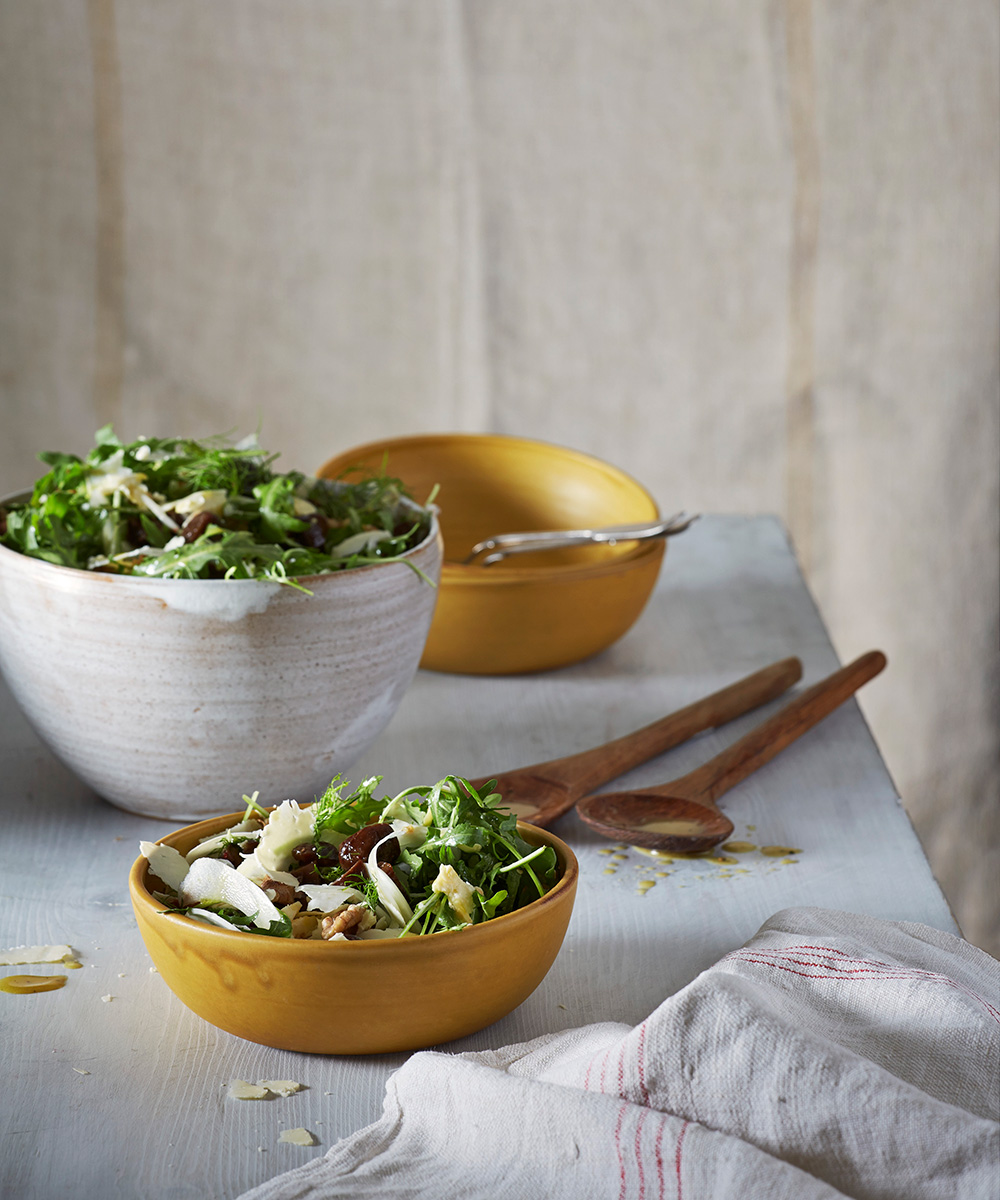
This is a delightful salad of crisp, salty, sweet and hot contrasts, made with bold chestnut honey. Feel free to substitute a similar cheese, such as Berkswell, Parmesan or hard goat’s cheese, for the Caerphilly, but make sure it is free of animal rennet if serving vegetarians.
Serves 4
Ingredients:
For the dressing:
- 2 tbsp chestnut honey
- 1 tsp Dijon mustard
- 2 tbsp lemon juice
- Salt and black pepper
- 6 tbsp olive oil
For the salad:
- 2 tbsp walnut halves
- 2 fennel bulbs, trimmed and halved, any fronds chopped and reserved
- 2 tbsp olive oil
- 180g cooked chestnuts (vacuum-packed is fine), roughly chopped
- ½ tsp dried chilli flakes
- 1 tbsp chestnut honey
- Large handful of rocket leaves
- 120g Caerphilly cheese, shaved or finely sliced
Method:
1. To make the dressing, whist the honey, mustard and lemon juice together with a twist each of salt and pepper. Slowly whist in the oil to make a thick dressing, then finish by whisking in 1 tablespoon of water to lighten the consistency.
2. Preheat the oven to 200°C, gas mark 6. Spread out the walnuts on a baking tray and toast for 6-8 minutes, until golden. Set aside to cool, then roughly chop.
3. Use a mandolin, the slicing blade of a food processor or a very sharp knife to slice the fennel as water-thin as possible. Submerge in a bowl of iced water for a few minutes to crisp. Meanwhile, put the olive oil in a large frying pan over a high heat. Add the chestnuts, chilli flakes and cook, stirring often, for a couple of minutes, until browned. Add the honey and cook for a few seconds to glaze. Remove from the heat.
4. Drain the fennel well and put in a mixing bowl with the rocket, any chopped fennel fronds and a few spoonfuls of the dressing. Gently tumble the Caerphilly and hot chestnuts through.
5. Divide the salad between serving plates. Scatter with the toasted walnuts and spoon the remaining dressing over.
Griddled Vietnamese-style pork patties with lemongrass, honey and sticky rice
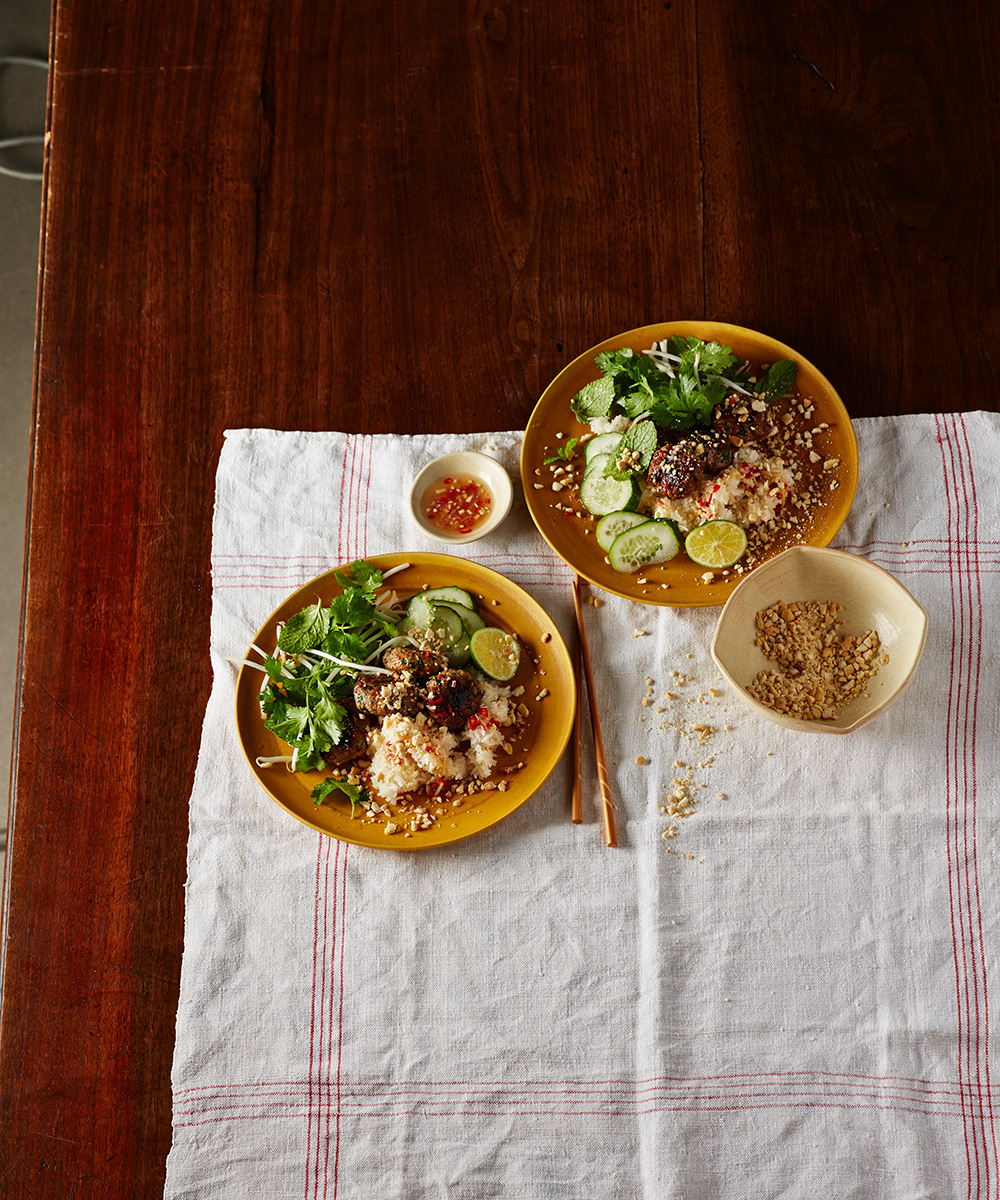
Incredibly simple to make, these aromatic patties with sticky rice and fragrant herb salad are wonderfully evocative of the bustling streets of Vietnam. Nuoc cham is a zippy dressing and dipping sauce that’s widely used in traditional dishes.
Serves 4
Ingredients:
- 250g Thai sticky rice
- 2 garlic cloves, peeled and finely chopped
- 1 red chilli, deseeded and finely chopped
- 2 lemongrass stalks, ends trimmed, outer layers removed and soft inner finely chopped
- Thumb-size piece of fresh ginger, peeled and finely chopped
- 3 ½ tbsp mild honey
- 4 tbsp fish sauce
- 600g pork mince Juice of 1 lime
- 3 tbsp rice wine vinegar
- Large handful mint
- Large handful coriander1 tbsp groundnut oil
- ½ cucumber, sliced
- 150g bean sprouts
- 60g roasted cashews, crushed
Method:
1. Soak the rice in plenty of cool water for at least 4 hours or overnight. Combine the garlic, chilli, lemongrass and ginger in a small bowl with 3 tablespoons of the honey and the fish sauce. Transfer 2 tablespoons of this mixture to a large bowl with the pork mince. Add the lime juice, vinegar and 2 tablespoons of water to the remaining mixture to make the nuoc cham dressing. Cover and chill until needed.
2. Chop a third of the mint and coriander, setting the rest aside. Add the chopped herbs to the pork mince and mix well to combine evenly (this is easiest to do with clean hands). Shape into about 20 rounds, each the size of a walnut, then flatten slightly with the palm of your hand to form patties. If you have time, space them out on a baking sheet, cover with clingfilm and chill for at least 20 minutes or up to 24 hours to firm up.
3. Bring the patties up to room temperature for 30 minutes before cooking and rub lightly with the oil. Drain the rice, combine with a pinch of salt and spoon into a steamer tray set over simmering water. Make a few holes with the handle of a wooden spoon and steam for 20 minutes. Stir and steam for 5 minutes more.
4. Set a large frying pan over a high heat. Working in two batches if necessary, add the oiled pork patties to the pan in a single layer. Cook for 2-3 minutes on each side, until browned all over and pipping hot through. Drizzle with the remaining ½ tablespoon of honey (dividing between the two batches, if needed) and cook for a minute more to caramelise.
5. Divide the rice, cucumber, bean sprouts and remaining mint and coriander between four plates. Spoon a little of the nuoc cham sauce over each serving and put the rest in small dipping bowls to serve alongside. Scatter with crushed cashews to finish.
Roast chicken with thyme, garlic, lemon and honey
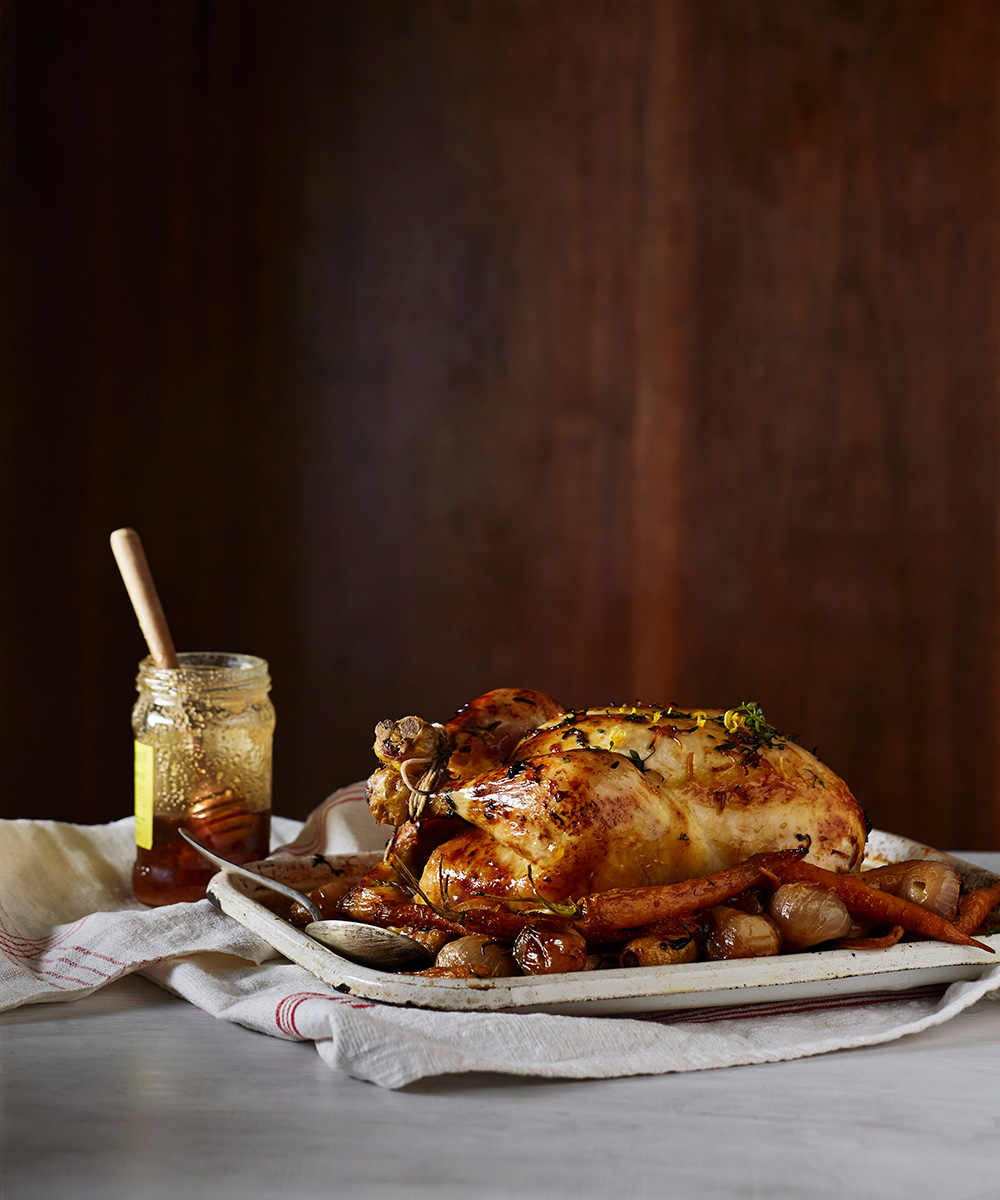
This deeply savory dish with its honey – and lemon –spiked gravy and sticky vegetables, served on a bed of soft polenta with steamed winter greens, makes a delicious and satisfying kitchen supper.
Serves 4
Ingredients:
- 2 large lemons; 1 zested and juiced and 1 sliced
- 2 garlic cloves, peeled and crushed
- 4 sprigs thyme, leaves stripped and chopped, plus extra to serve
- 3 tbsp honey
- 2 tbsp olive oil2kg chicken
- Handful of small shallots, peeled
- 300g baby carrots, scrubbed, tops left on
- 300g baby parsnips, scrubbed and trimmed
- Salt and black pepper
- 200ml chicken stock
1. Preheat the oven to 200°C, gas mark 6. Combine the lemon zest and juice with the garlic, thyme, honey and olive oil.
2. Pop a few of the lemon slices inside the chicken cavity and tie the legs together loosely using kitchen string. Nestle the chicken in a sturdy, roomy roasting tin, surrounded by lemon slices, shallots, carrots and parsnips. Pour the honey mixture over everything and season well with salt and black pepper.
3. Roast for 50 minutes, basting once or twice, then add the stock to the tin, give everything a good stir and roast for a further 20 minutes, covering the chicken with a layer of foil if it is browning too much. Remove from the oven, cover loosely with foil and leave to rest for 15 minutes.
4. Scatter fresh thyme leaves over the chicken, then joint it into pieces. Serve the chicken with the vegetables and the simple roasting gravy from the tin (spoon off most of the fat first).
Dark chocolate mousse with honeycomb and crushed hazelnut praline
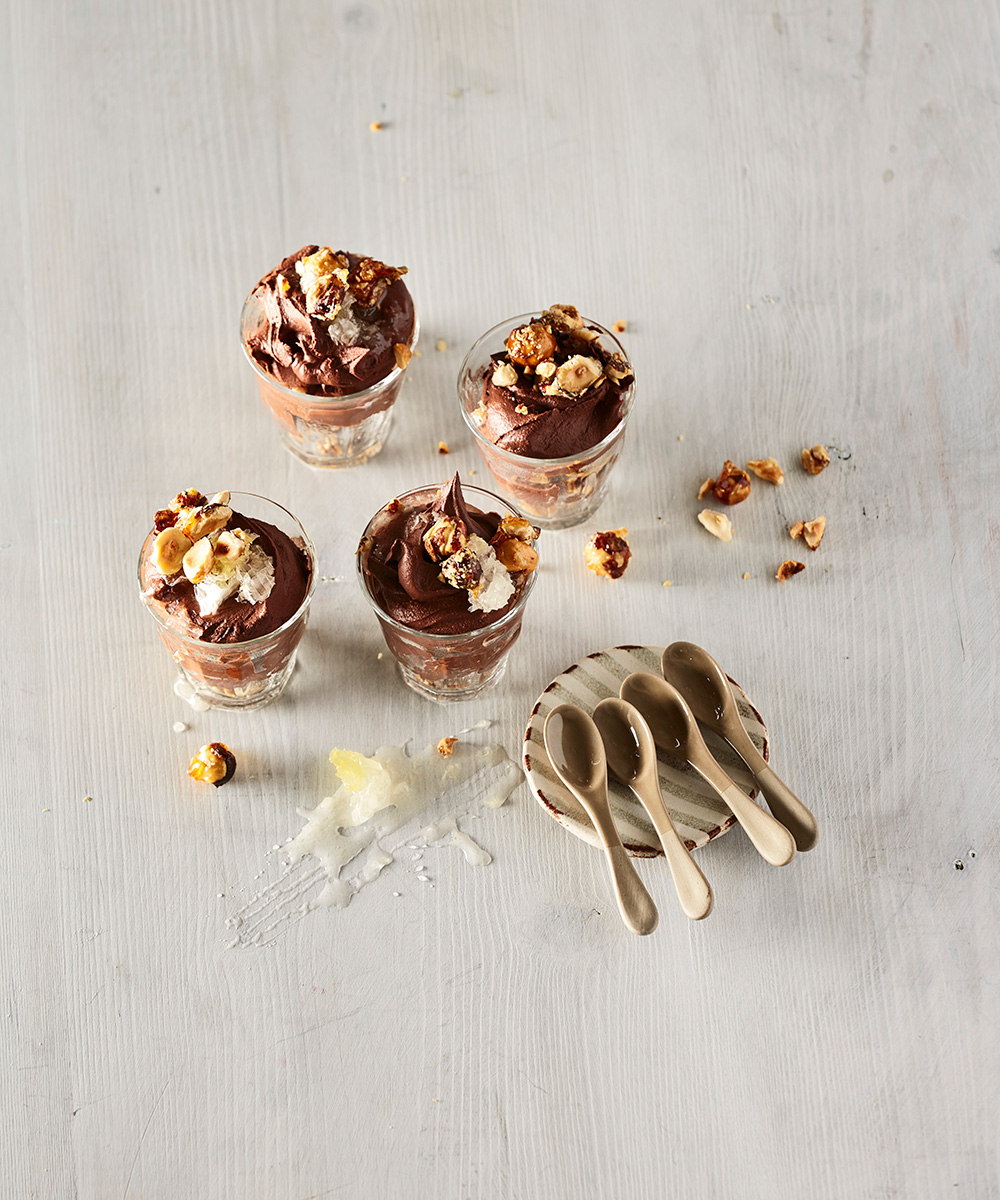
This exceptionally intense, dairy-free chocolate mousse is made with just a handful of simple ingredients, layered in glasses with a salty-sweet nut praline. The result: a rich, sophisticated pudding that’s perfect for a dinner party.
Serves 6
Ingredients:
For the praline:
- Sunflower oil, for greasing
- 100g blanched hazelnuts
- 2 tbsp light brown sugar
- 2 tbsp honey
- A large pinch of fine salt
For the mousse:
- 300g of 70% dark chocolate
- Large pinch of fine salt
- 2 tbsp runny honey
- 2 tsp vanilla bean paste or vanilla extract
- 100g honeycomb, broken into pieces
1. To make the praline, preheat the oven to 180°C, gas mark 4. Lightly brush a medium baking sheet with oil. Combine the hazelnuts with the brown sugar, honey and salt in a bowl and toss well to coat. Spread out on the baking sheet and bake for 5 minutes, then stir and bake for a further 3-4 minutes, until caramelised. Leave to cool, then crush roughly.
2. For the mousse, put the chocolate, salt and honey in a saucepan with 260ml water. Set the pan over a low heat and warm the mixture through, stirring occasionally, until the chocolate has melted. Remove from the heat and stir in the vanilla paste or extract.
3. Pour the mixture into a bowl and whip with a balloon whisk until the chocolate thickens and looks shiny. This can take a while, but watch closely and stop before it looks like a mousse, as it will continue to set. If you take it too far and the mixture stiffens, re-melt it over a gentle heat with 1 teaspoon of water then whisk again.
4. Put a small amount of praline in six small glasses and top with enough mousse to reach the halfway point. Repeat the praline and mousse layers, reserving a little praline. Spoon honeycomb pieces on to each mousse and scatter the remaining praline over.
Honey, orange and rhubarb shrub cocktail
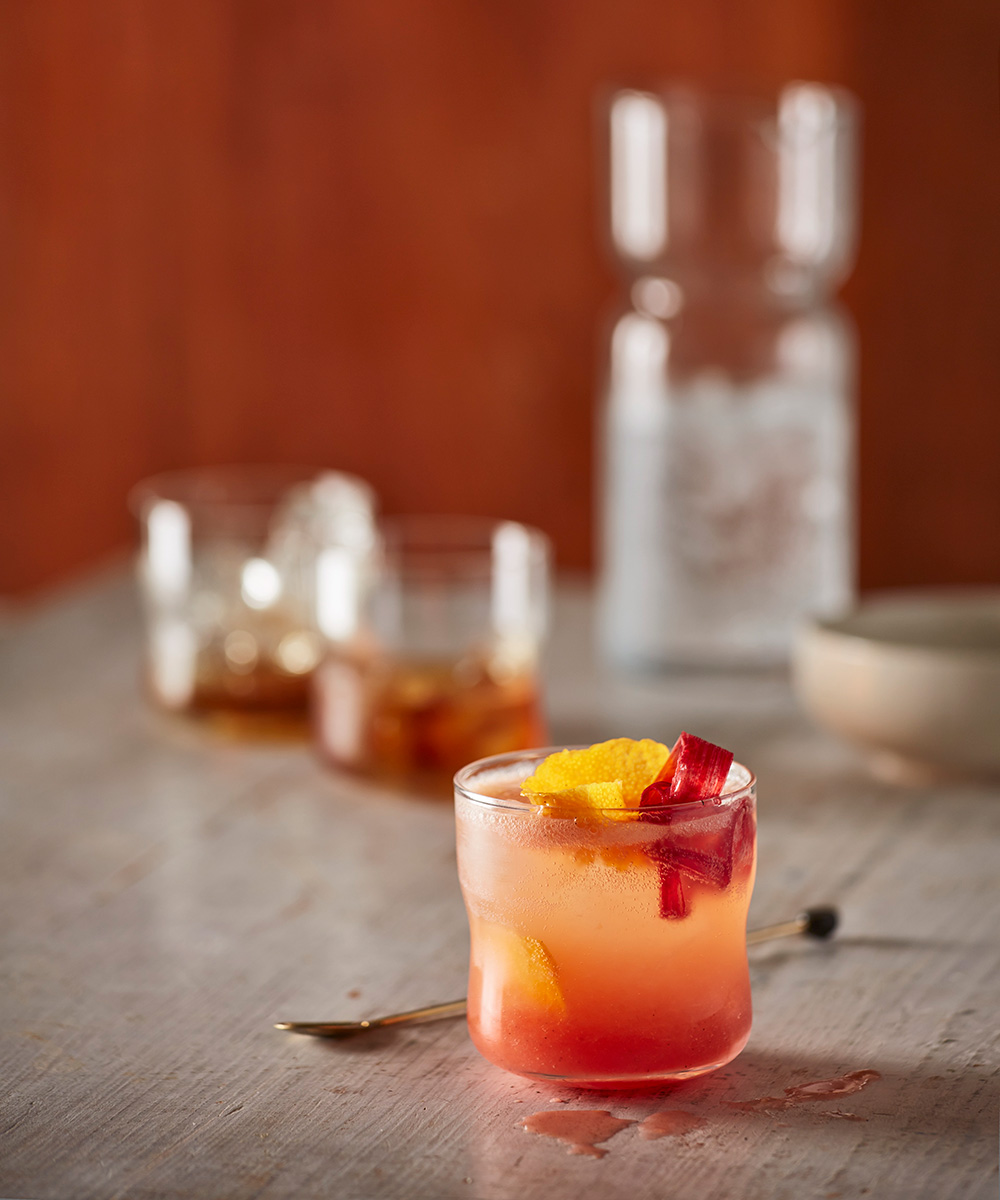
A shrub is a fruit and sugar syrup, perfect as a fragrant cocktail base. Here, the sugar component is honey and the fruit is shocking-pink rhubarb with a hint of orange. Top up with sparkling water, ice and perhaps a shot of bourbon, if you like.
Makes 10-12 servings
Ingredients:
- 400g rhubarb, trimmed and roughly chopped
- 150g blossom honey
- ½ vanilla bean
- 300ml freshly-squeezed orange juice
- Ice cubes and sparkling water, to top up
- Bourbon, optional
- Rhubarb shavings and pared orange peel, to decorate
1. To make the rhubarb purée, combine the rhubarb, honey and vanilla pod half in a saucepan with 50ml water. Simmer gently, stirring often, for about 10 minutes, until the rhubarb is soft and broken down. Leave to cool.
2. Stir the orange juice into the rhubarb and remove the vanilla pod. Pass the mixture through a sieve, scraping well to push through as much as possible.
3. Divide the mixture between serving glasses, aiming to fill each glass by about a third. Add ice cubes and top up with sparkling water, adding a shot of bourbon to each glass, if liked. Decorate with rhubarb shavings and orange peel.
Photography/ Jan Baldwin
Styling/ Karen Akhtar
Alice Hart is a food writer and recipe developer, working across a wide variety of media, from magazines to books. Alice’s recipe books are based on wholesome produce and seasonal eating, and while she takes a balanced approach, using wholefoods and vegetables wherever possible, she also finds joy in an excellent cake. Alice is also invested in sports nutrition and is a Level 3 personal trainer, a seasoned endurance sports competitor and a trained chef.